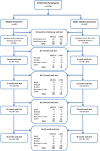Six-minute walk distance after coronary artery bypass grafting compared with medical therapy in ischaemic cardiomyopathy
- PMID: 29531766
- PMCID: PMC5845417
- DOI: 10.1136/openhrt-2017-000752
Six-minute walk distance after coronary artery bypass grafting compared with medical therapy in ischaemic cardiomyopathy
Abstract
Background: In patients with ischaemic left ventricular dysfunction, coronary artery bypass surgery (CABG) may decrease mortality, but it is not known whether CABG improves functional capacity.
Objective: To determine whether CABG compared with medical therapy alone (MED) increases 6 min walk distance in patients with ischaemic left ventricular dysfunction and coronary artery disease amenable to revascularisation.
Methods: The Surgical Treatment in Ischemic Heart disease trial randomised 1212 patients with ischaemic left ventricular dysfunction to CABG or MED. A 6 min walk distance test was performed both at baseline and at least one follow-up assessment at 4, 12, 24 and/or 36 months in 409 patients randomised to CABG and 466 to MED. Change in 6 min walk distance between baseline and follow-up were compared by treatment allocation.
Results: 6 min walk distance at baseline for CABG was mean 340±117 m and for MED 339±118 m. Change in walk distance from baseline was similar for CABG and MED groups at 4 months (mean +38 vs +28 m), 12 months (+47 vs +36 m), 24 months (+31 vs +34 m) and 36 months (-7 vs +7 m), P>0.10 for all. Change in walk distance between CABG and MED groups over all assessments was also similar after adjusting for covariates and imputation for missing values (+8 m, 95% CI -7 to 23 m, P=0.29). Results were consistent for subgroups defined by angina, New York Heart Association class ≥3, left ventricular ejection fraction, baseline walk distance and geographic region.
Conclusion: In patients with ischaemic left ventricular dysfunction CABG compared with MED alone is known to reduce mortality but is unlikely to result in a clinically significant improvement in functional capacity.
Trial registration number: NCT00023595.
Keywords: clinical trial; coronary artery bypass grafting; exercise capacity; ischemic cardiomyopathy; six-minute walk distance.
Conflict of interest statement
Competing interests: JGHC: Medtronic advisory board. HDW: grants and non-financial support from GlaxoSmithKline during the conduct of the study; grants from Sanofi Aventis, Eli Lilly and Company, National Institutes of Health, Merck Sharpe & Dohm, Omthera Pharmaceuticals, Pfizer New Zealand, Intarcia Therapeutics Inc, Elsai Inc, DalGenE Products and Services; grants and personal fees from AstraZeneca, outside the submitted work. EJV: research grants from NHLBI, Alnylam Pharmaceuticals, Amgen, Novartis Pharmaceutical Corp and Pfizer; consulting services for Amgen, Merck & Co and Novartis Pharmaceutical Corp; and speakers bureau honoraria from Expert Exchange.
Figures



References
Publication types
Associated data
Grants and funding
LinkOut - more resources
Full Text Sources
Medical
